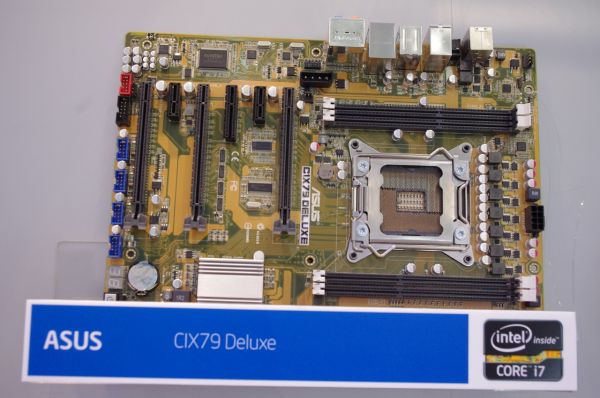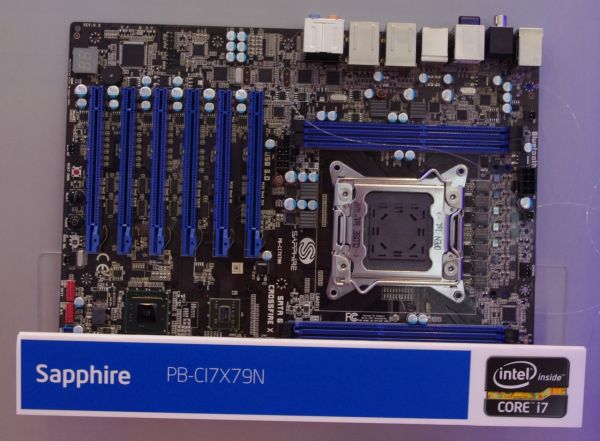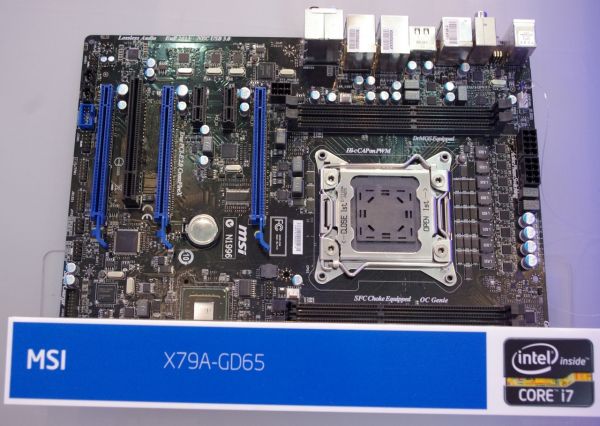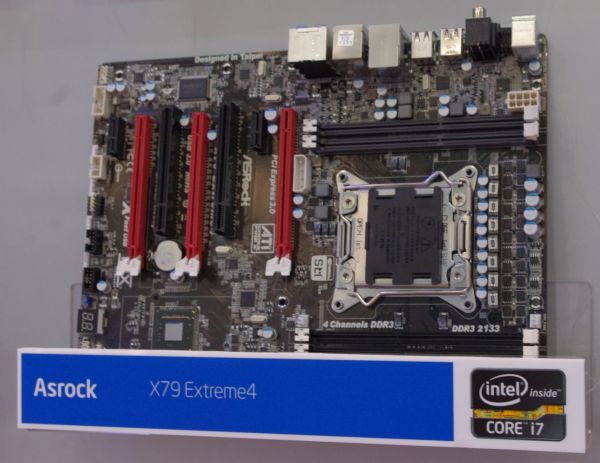Computex 2011: Twelve X79 Motherboards
by Ian Cutress on June 1, 2011 11:44 AM EST- Posted in
- Computex 2011
- Motherboards
- Trade Shows
Almost all the major motherboard manufacturers have had some form of X79 on display – Anand has already shown you the MSI and ECS offerings, but I stopped by the Intel booth today to a magnificent display. Almost every X79 board at Computex was on show, so let us play a game of spot the difference.
Of the 12 models on display, ASUS alone have six – the C1X79, C1X79 LE, C1X79 EVO, C1X79 PRO, C1X79 Deluxe and the C1X79 Plus, which covers most of their standard P67 launch model names. We have one from Sapphire (PB-C17X79N), one from ECS (X79R-A), one from ASRock (X79 Extreme4), and three from MSI (GD65, GD70 and GD80) also.
All the X79 on show are likely to be early engineering samples or mockups – this is more than clear with the brown PCB shown on the ASUS boards and the lack of cooling on the VRMs across most on display. The lack of I/O on the ASUS boards adds more to this realisation.
The Sapphire model is interesting given that it contains 6 full length PCIe and an 8-pin 12V connector, whereas the ECS board has four PCIe – possibly color coded for an nForce 200 quad GPU configuration.
The MSI series starts with the high end GD80 having a blue PCB with a PCH fan, an 8-pin power slot and an angled fan cooler. Unfortunately it seems the display had the GD70 and GD65 boards in the wrong place, as the board above the GD70 said GD65 however where the GD65 was, there was a sticker over the model number and that board required two 8-pin PCIe. Perhaps it was a new GD90 designation in this spot to confuse us?
It will ultimately be a while before we can get our hands on working boards to let you know how they feel, but stay tuned – this is an exciting time for the CPU and motherboard industry. Have a look at the gallery for the full X79 line-up from the Intel booth.




















29 Comments
View All Comments
DanNeely - Wednesday, June 1, 2011 - link
That's correct.AdamK47 - Wednesday, June 1, 2011 - link
Do they plan on supplying triple SLI bridges with an extra long space between the first and second card? Seems like most of these boards have that extra space.8steve8 - Wednesday, June 1, 2011 - link
full size atx is so 1999peternelson - Wednesday, June 1, 2011 - link
"Almost every X79 board at Computex was on show, so let us play a game of spot the difference."
I spotted the difference!
Of all the gallery pictures, the ECS board is the odd one out.
It is the only board printed explicitly with the wording "PCIe Gen 3"
These are the magic words I was looking for. This may provide a proper upgrade path to the Ivy Bridge cpu revision. Doubtless Nvidia will move to support PCIe Gen 3 around launch. I don't want to be buying another board so soon after.
So, can we confirm, is it really Gen 3? Are the other motherboards Gen 3 capable but just don't say so explicitly? It still seems unconfirmed which if any lanes on the X79 chipset will be Gen 3 vs Gen 2. Seems unlikely ECS would screenprint their board with a feature it can't support so perhaps it IS true.
Sapphire have a good idea with x16 slots.
The lack of PCI from all but Asrock(2) and the MSI (GD65) is no great loss these days. Anyone who was desperate to connect a vital PCI card could always do it using an external bridge box like those from Magma.
It seems Asus has moved away from using a TPM header to connect POST display and buttons on a separate "Doctor" diagnostics PCB. Although some cases could not fit it I really liked it, exposing the LPC bus for optional TPM module (if you could source one). It did seem to make the jump to Sandy Bridge but now seems strangely missing, even on such high end enthusiast system.
What I'd really like to see is the successor to my Asus P6T7 Supercomputer board, and it must be PCIe Gen 3 capable, with good I/O. That is, an updated 7 slot monster for parallel GPU (Tesla/Quadro/Geforce). Hopefully they see the benefit in launching such model subject to Nvidia licensing. Failing that, a more modern P6T6 Workstation Revolution, or something like an updated SR-2.
ypsylon - Thursday, June 2, 2011 - link
It is good to see that at least some manufacturers put one PCI slot. I do require one for my "uber" sound card. Card was worth more than my x58 motherboard itself and it doesn't work when plugged into PCI-PCI-Ex riser/converter.BTW: They have one great labeling machine at Asus. Same board, many, many different stickers. Must be working overtime behind scenes. ;)
peternelson - Thursday, June 2, 2011 - link
Yes, specialised pro audio soundcards were one of the niche areas I was thinking of. Another was scientific instrumentation for labs eg National Instruments cards which can easily cost more than the motherboard. Actually I even designed FPGA interface firmware for some custom PCI cards myself. Even with all these considerations, I feel PCI Express slots are now more useful to me.I agree that PCI is not dead, and won't be, as long as there are affordable but still operational cards around on ebay for less than contemporary PCIe versions (assuming they exist). Only a few weeks ago, a friend of mine was looking for a motherboard supporting *ISA* slots for similar reasons, that probably is taking things a bit too far ;-)
Sorry the converter bridge didn't work for you.
Etern205 - Friday, June 3, 2011 - link
From the 6 Asus boards some lack the Com port header, diagnostic led and onboard reset/power switch.But why did they place that fan header on the top right corner?
Also from all the board it seems there is no mounting holes to install the HSF?
If the outer holes on the socket is for the HSF, does this mean SNB-E (even their stock) to be a
screw on with a black plate and no more push pin?
cmircea - Sunday, June 5, 2011 - link
What is this bullshit with impossible to route traces? How come the likes of Supermicro, Quanta and Tyan can do it with not only four, but EIGHT DIMMs, but ASUS and others can't?Here's a definite example:
http://www.supermicro.com/Aplus/motherboard/Optero...
It has eight DIMMs, quad-channel, in ATX form factor, with six expansion slots. It also has the DIMMs in line with airflow, parallel to the top of the motherboard - this way they don't need heatspreaders since air moves between them from the front of the case.
How come Supermicro can use an extra PCB layer and ASUS can't? This excuse is just bullshit. They are cutting cornes on their highest-end motherboards to save a few cents off each motherboard, then forcing everyone else to redesign heatsinks and memory heatspreaders (cause they're too stubborn to put the DIMMs in their proper orientation).
henhaohenhao - Wednesday, July 13, 2011 - link
Come go and see, will not regret it Oh look
http://www.ifancyshop.com